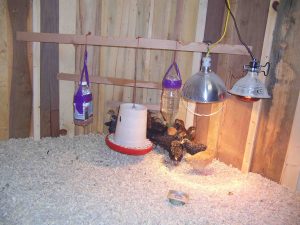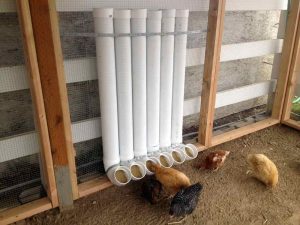Decentralization is the key to divorcing ourselves from the centralized corporate-government Octopus that has wrapped its tentacles around our lives – and our throats. The more we can do for ourselves, the less the Octopus can make us do.
Like wear a “mask.” Or get a Shot.
In order to buy food, for instance. 
It’s why I’ve gotten into raising chickens and ducks, the self-perpetuating food source. A small flock of 6-12 birds can provide enough protein – in the form of eggs – to keep you well-fed in the event you can’t buy eggs (or other forms of protein) at the store, without wearing a Lie Rag or (perhaps soon) showing Proof of Jab. And unlike a carton of store-bought eggs, which are gone once eaten, your carton will refill itself on a daily basis. Probably you will end up giving away (or trading) the eggs you don’t eat.
If you have a rooster – or a drake (male duck) – you will also have self-replicating meat. Or birds to trade/sell. Fresh/farm-raised chicken commands top dollar and fresh/farm raised duck commands surreal dollars. How’s $40 per dressed bird sound? Not bad, if you raise/sell a half dozen extra every few months.
But you will need a coop – a secure place to keep the birds – which brings me to the subject of this article. I have built two so far over the past 15 years or so and am now embarked upon the third, which will benefit from the experience gained from the first two.
Unlike the last two, it will be attractive. And – I hope – far more functional.
It will be wide (eight feet) but not too deep (three feet on each side) with the front side being a pair of carriage doors that open outward and provide complete access to the interior of the coop, for both egg-collecting and cleaning purposes. The sides will be built on concrete footers – I’m getting ready to pour the concrete – for structural strength and to keep the wood off the dirt, which inevitably rots wood. It may become hard to get wood – as in siding – in the months and possibly years ahead. I want the siding I panel up to be sound for the next 20 years, at least.
Also, it will keep predators from getting in.
The far wall will be lined with laying boxes for the hens stacked on one side, with the other side being a nesting area for the Muscovy ducks, which prefer to lay on the ground (on straw, I find). The chickens prefer to roost. But you should keep in mind the poop – which will drop from wherever they roost onto whatever is underneath. Hence – per the ’90s song – I like to keep them separated, laterally as well as vertically.
On the left wall, a small door for the birds to enter and exit the coop as they like. This opens to a secure run with wire fencing encompassing, to keep the birds from being eaten by raccoons and other predators and also to enable me to not have to get up early to let them out or sweat forgetting to lock them in come dusk. The “safe” run will open up to a larger run – also fenced, but not overhead – that is safe enough for supervised daytime activities. 
The coop will be much easier to keep clean – a constant issue with chickens and ducks – than my last two coops, which were put together more like a structure for humans than for birds. I learned some valuable lessons. Among these, that coops are mostly for roosting and brooding. Unlike us, the birds prefer to be outside most of the time, so the space they need inside is less than we’d need. And the smaller space is not just easier to keep clean – especially with a set of wide-opening carriage-style doors at the front. It is also easier to keep it warm in the winter.
This is an important consideration if you intend to raise birds in a cold climate. Especially as regards chickens, which are quite heat tolerant but vulnerable to frostbite on their combs in the winter, which can kill them. A smaller space will be warmer, naturally – and if you do as I am doing and run electricity to the coop, it will cost you less to keep it warm artificially, via a small heat lamp.
Electricity in the shed is a thing you’ll want to have for more than just heat for the birds, too. As winter descends, so also early darkness and not being able to see – or having to using a flashlight to see – is a pain, especially when you are trying to collect eggs. Having an electrical outlet inside the coop will also make it easy to plug in brooder equipment, if you need to help the hens raise the next generation.
Another idea I picked up is to use PVC piping to rig up self-serving feeders and waterers – so you can fill up both say once a week as opposed to feeding and watering the birds every day. You can design these in almost any way that you like but the general idea is a vertical section with a cap on top and then an “L” on the bottom that distributes the food/water. In the case of water, you will probably need to rig a float system (as in a toilet or a carburetor) to maintain the water flow/level. A small electric heating element can keep everything from freezing that ought to flow.
The coop will have a metal roof with an alpine slope to slough off rain and snow. The entrance roof height will be about seven feet, tapering to about six at the back. Tall enough for walk-in access and not having to hunch over to get at the eggs in the boxes.
To make it pretty, there will be flower boxes on the side and a gated walkway and concrete pad entrance, with covered storage (under the eaves of the adjacent shed) for extra hay and such. I’ll have some videos and pics soon.
Once this gets done, it’ll be time to start on the greenhouse!
. . .
Got a question about cars, Libertarian politics – or anything else? Click on the “ask Eric” link and send ’em in! Or email me at [email protected] if the @!** “ask Eric” button doesn’t work!
If you like what you’ve found here please consider supporting EPautos.
We depend on you to keep the wheels turning!
Our donate button is here.
If you prefer not to use PayPal, our mailing address is:
EPautos
721 Hummingbird Lane SE
Copper Hill, VA 24079
PS: Get an EPautos magnet or sticker or coaster in return for a $20 or more one-time donation or a $10 or more monthly recurring donation. (Please be sure to tell us you want a magnet or sticker or coaster – and also, provide an address, so we know where to mail the thing!)
My eBook about car buying (new and used) is also available for your favorite price – free! Click here. If that fails, email me at [email protected] and I will send you a copy directly!












Its taken me about two full days to dig a (14″ deep, 24″ out) trench around my chicken coop and lay down some 1/2″ mesh as an apron.
Much of the time I thought about how much easier it probably is to put in a concrete foundation. Never having worked with concrete, other than using a sledge hammer on some, I don’t know.
Just about every time a dirt clod fell down into my boot as I was working in the trenches I imagined Eric sitting back in a shady spot while sipping on some exotic coffee watching a slab being poured. Easy peasy?
If I had to do it over again, and it was in my budget, I’d get concrete over an apron. I just keep wondering how long that wire mesh will last as a rat barrier vs. concrete.
On the side I think rats will hit hardest I did as some have suggested and sprayed some leak seal on the mesh before laying it down. When I was digging I found quite a few strands of ~ 20+ yr. old electrical wire which looked close to new. So, we’ll see how well leak seal does? Or, better yet, I never have a problem and the stuff just stays buried.
Hi Helot,
I’ve been digging, too – for the past three days, around a yuge underground root that I eventually chain-sawed and sledgehammered the necessary chunk out of. Now I can pour the footers… if the rain ever stops.
Concrete slabs aren’t hard. Well, once they are dry they should be. But the prep is just digging, bedding and framing. The biggest deal is having enough concrete ready if the area is large; it is hard to do this without a mixer – better yet, have a truck come and just dump however much the prepped site requires.
My coop is going to be eight feet long by three feet wide. The foundation will be concrete set slightly above ground level, with pressure treated 4×4 post framing and T11 siding and barn-type swing out doors on the front. I will do a video and follow-up article once the forms are in the ground and the concrete is poured… once the rain stops!
Eric, have provisions for locking the door to the coop. Two-legged varmints can be worse than the others you’re concerned about.
My mother, stepfather, and I had a problem with theft when we lived in rural Southside Virginia years ago. We had bought 200 small chicks and one night, after they had a little size, over 100 disappeared from the closed coop, never to be seen again. Eggs had already been disappearing from the other coop. There were no eggshells, blood, carcasses, body parts, or anything.
A predator would have left evidence. There was no evidence.
It was clear someone was stealing. Over time they also helped themselves to our garden, including all of our Silver Queen corn the night before we were going to pick it. It wasn’t deer; the stalks were picked clean.
When the shit hits the fan, those of you planning to keep poultry, have a garden, whatever, need to think about the possibility others will simply come and steal what you have. It’s going to be a bigger possibility than pest animals doing the same. Plan to secure your stuff as well as you can.
Hence why an AR-15 or even a WWII vintage M1 carbine makes a great “varminter” — either four or two a legged!
I have read about that happening now, ekrampitzjr.
I think it was at Backyardchickens, as I recall, could be a bit foggy, a woman used to sell poultry, then stopped, some people demanded to still get some, even went so far as to climb a 4′ fence to get to her stuff. I imagine she was a bit freaked out about it.
I contemplated putting locks on mine, yet I just kept thinking all they needed was a hex-screwdriver or a pair of wire cutters and they’d be in like Flin. Then, I started thinking about the stuff FerFal wrote about years ago and how criminals would use saws-alls to cut right through the siding to get into peoples houses.
Locks are only blocks for honest people. YMMV? Idk. It might help? Lots of stupid criminals out there who don’t know how to use wire cutter or even know what a hex-bit is.
Coop 1 looks nice but I would be tempted to put coarse screen at the top to keep out foxes or large flying creatures and large insects. Like the red door on your garage.
Morning, to5!
It’s pouring here – finally, we needed it. Bad news – for me – is that no concrete footers get poured today. But I will make the forms and get ready to pour; maybe tomorrow. There will be pics and maybe a video!
For those who are restricted from raising chickens due to govt dictates – rabbits may be for you.
They are essentially silent, reproduce like —- rabbits, and provide meat in relatively short amount of time.
They can be kept in smaller areas, heck even in chicken coops.
And no one who can’t see them will know you have them.
RE: “For those who are restricted from raising chickens due to govt dictates –”
Once upon a time, Never would I have thought chickens would be required to be registered with, The City.
The city I once lived in, in Iowa, of all places, requires – requires – all chickens in The City to be registered with them. I don’t know what that entails, probably a Chicken Tax!? And, absolutely No Roosters Allowed.
Rooster discriminating segregationist bastards, it’s not like their crowing is louder than the, ‘Boom, Boom, Boom’ thumping of the stereos in the $1,200 Dollar cars with $5,000 Dollar wheels going by at all hours of the day, or the idiots with the straight pipe Harley’s riding though a residential neighborhood at 2 A.M. … but, I digress. Maybe?
I have 3 rabbits, I plan to expand. All the while I sometimes think of how it is said a person can starve if they just eat rabbit. I guess that’s why I’m trying to garden, too.
I wonder if any of you have, or are thinking of having, a chicksaw?
I’m contemplating a mini-one, someday.
Ha! Asking all these chicken & wabbit westions on a car blog. Funny, that.
The town I live in demands that all cats and dogs be registered with the city and an annual “permit” must be purchased for around $40 each.
I presume dog & cat tags are the slippery slope they use to justify registering chickens, used much like Eric is presenting in his, Health Kulaks article today.
It’s odd how the State clearly expects the owners of dogs, cats & chickens to be held accountable for the actions of those animals, yet when the State basically claims ownership of all wildlife and say, a whitetail deer, bounds in front of your car while you’re driving, the resulting smashed up front end of your car is not something a person can hold the State accountable for.
But, just try & trap, shoot or otherwise capture any of the wildlife which the State claims and you’ll likely see the hammer & or the slammer. Funny how that works.
It’s not like the country-side is a whole lot better than The City.
Apparently, in my state at least, if a person has more than 99 chickens, they gotta get a State issued chicken permit and submit to regular inspections, or some such sheet.
Are there poultry police who go around counting chickens or looking for potential chicken number violations?
Yeesh, the more I learn, the more fucked up the world seems to be.
Ranchers out west follow the “Three-S” rule when dealing with predators: Shoot, Shovel, and Shut-up.
Hi Dan,
You know what else is good about rabbits? They taste like….yes, chicken.
Great story from my youth. My Pops invited my girlfriend and I over for dinner one day, said he was going to bbq some”chicken”. So we’re eating and I notice, in my head, that these aren’t chicken bones. I’m like, whatever, tastes great! I don’t say a word.
So, after we’re done eating my dad asked, well kids, how did you like that chicken? My girlfriend was like, Oh, that was great pops! And I said that was good dad. Then my dad says, “that wasn’t chicken, that was rabbit”. The look on my girlfriends face was fuckin’ priceless! I immediately say, “I fucking knew it wasn’t chicken”, and then pointed at the dish with the bones on it, ‘those ain’t chicken bones!” My dad is bent over laughing so fucking hard, then I start laughing, my girlfriend is still fucking stunned. “Oh my god, I ate Thumper!”
These two bits were, The Best to read, a sigh of relief I might be on the correct path:
“Second I can confirm the deep liter method works best.”
“We clean it out once maybe twice a year.”
Especially, that last one.
If you don’t mind my asking, when you say, “Every month I add a little bit of fresh pine shavings”, do you buy this (how much$?) or do you have a chipper/shredder? I have yet to see a low cost one on Craigslist.
I was considering using grass clippings, but I’ve read if I put it on too thick, it’ll mold,… and that’s, bad?
I hope to hear more about your plan on incorporating some auto feeders and waterers. The PVC feeders in the photo, I thought, the chickens would poop in them.
My chickens sometimes drink out of plant-watering can thingy I leave out, it has a filler-hole just big enough they can stick their heads in. They seem to enjoy doing so. I wonder if that’s a blueprint for a feeder or other watering system?
I was talking to a chicken guy today, he uses 1 1/2 gallon plastic buckets for water. He said, that way, the chickens don’t scratch up stuff off the ground and into a shallow pan (like the rubber pan idea I mentioned).
In my current setup, I have a cinder block I put a shallow pan onto, that seems to work as well as a bucket for keeping stuff the chickens scratched up, out.
“chicken wrangling” I didn’t know that was a term. Cracks me up.
A few observations learned through trail and error of eight years of chicken wrangling. First is you really don’t need light in your henhouse. I found the less eggs I get in winter is more than made up for in spring and summer. Since we would keep our layers two to three years before sending them to the freezer the overall egg production remains about the same.
Second I can confirm the deep liter method works best. We have a floor made from 2×6, elevated on concrete piers attached to 4×4. We then bolted a dog run onto it and did some siding. We clean it out once maybe twice a year. Every month I add a little bit of fresh pine shavings and Diatomatous earth, thats it. when we finally clean it out the stuff on the bottom is almost composted and not as hot as straight chicken poo.
That picture looks like a great example, although I made my roof from corrugated metal. My chickens get enough light from being out in ‘the yard’ which surrounds the coop. A roof like that here would make the coop so hot it would cook the girls. They seem to like to lay the eggs in the cool of the shade.
I plan on incorporating some auto feeders and waterers. Right now we have so many neighbors who keep chickens so its easy to trade off letting them out, feeding, watering, and collecting eggs if we take a trip. Don’t know that that will always be the case.
Hatteraszek has got that right about the heat and humidity. Where I am, it’s been miserable for weeks, dripping sweat while building sure does add to making mistakes. But, chickens don’t care if the door is a bit crooked, do they?
I’m planning to do the deep litter thing. Hosing stuff off would be nice, but I’m trying not to spend as much $ as I can (reclaiming pallet wood for much of it, per you guys) AND I’m planning on how a setup would work without power, which means maybe no water except what I get from a lake or something, and… what to do about water? I often ask myself, “What would Pa, do?” One hundred years ago.
The best option I’ve seen or read about is rubber water bowls, a fella up in Alaska wrote some good things about them. I think they’ll be perfect for chickens, how-freaking-ever; the rabbits eat the danged things. I’m not sure what the best Winter time no-power water setup is for them.
When I first opened the article I thought, “Is that Eric’s coop?” and, “I guess he ain’t got: coyotes, foxes, raccoons, mink, rats, or big snakes around his place cause That coop didn’t seem like it would stop any of them from getting a quick snack.
I’m in the process of building tiny doors to access the nest boxes from outside the coop. I reckon the less time I’m inside the coop, the better.
Next up is an apron, being as you have concrete, you don’t have to dig that step. I’m looking forward to the photos.
Oh, and I forgot, possums.
I’ve read some gruesome stories about possums and their chicken killing ways. Our overlords probably envy them and their abilities.
Hi Helot,
Same here – in re the suffocating, obnoxious heat lately. But work proceeds… hoping to get the forms for the footers in today and maybe do the concrete, if it doesn’t rain. That’s the major work. The 4x4s and siding will go up quickly as there’s not much cutting to do. Regarding water sans power. I meant to mention this so am glad you brought it up. I intend to rig a rain water collection system that sluices water from the metal roof of my shed into a barrel and from there to PVC pipe that feeds a waterer, with a float type system to meter the flow. Usually, there is ample rain around here to keep a system like that working. But lately…
I wouldn’t start construction until a few weeks from now. The heat is unbearable. I imagine it’s similar near you in VA. Out here in coastal NC we’re at temps in the mid-90s with humidity near 100%. Even the wind is hot.
Sounds great, Eric! I had my first coop built but built the second myself spring of 2020. Both are 2′ off the ground supported by 4x4s and enclosed as part of the run, which has several benefits: no predator can live under the coop, discourages most snakes, provides shade from the Texas sun for the chickens, and easier to hose out the coop if a hole or two is drilled in the coop floor. The biggest mistake I made was to make the coop level – the water needs pushed out the holes when hosing out the interior.
The only predator problem so far have been king snakes, which drop from the nearby trees onto the coop roof and crawl in through the sheet metal roof bends. But king snakes only eat the eggs, so it could be worse. I fixed that by putting a wire mesh along the interior roof.
There’s no ramp for the chickens, as in the first photo of your article – all the chickens can fly into the 1’x1′ door opening.